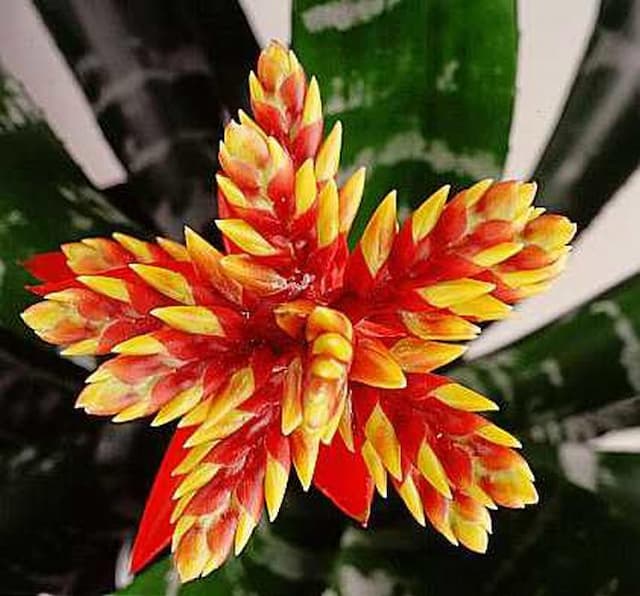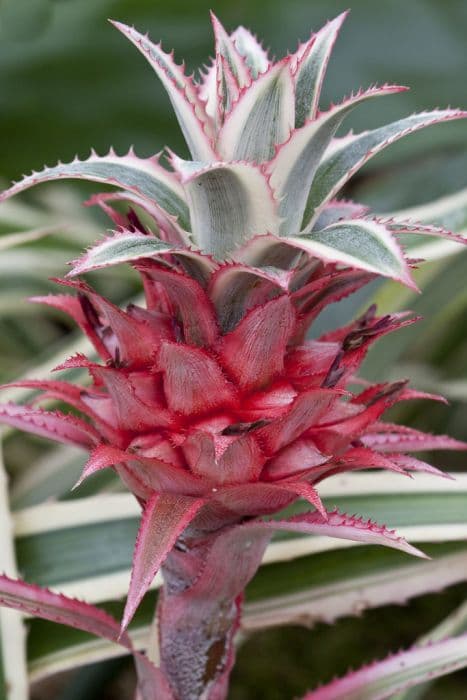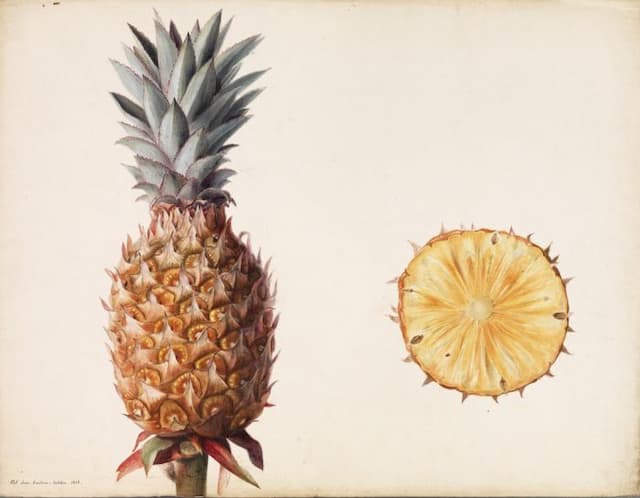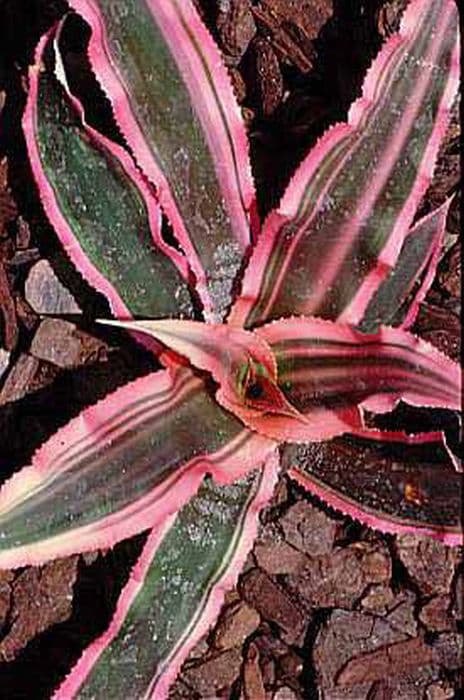Earth Star Cryptanthus zonatus

ABOUT
The plant known as Earth Star due to its shape is a striking sight. Featuring a rosette of leaves that spread outwards in a star-like fashion, it captures attention with its form, mimicking the symmetry of a celestial star fallen to the earth. The leaves themselves are stiff and often sport a textured appearance that may be bumpy or ridged. A defining characteristic is the variegated coloration that runs along these leaves. This variegation can be a series of stripes or bands that contrast starkly with the leaf color, often in shades of pink, red, or white against a deep green background. The overall impression is one of bold patterning that can be almost hypnotic. Flowering is not the most striking feature of the Earth Star, as the blooms are small and less showy when compared to the vivid foliage. However, the flowers do emerge from the center of the rosette, adding a subtle touch to the plant's overall appeal. The blend of coloration and form makes this plant a frequently admired selection for those seeking an ornamental piece to enhance their space.
About this plant
 Names
NamesFamily
Bromeliaceae
Synonyms
Earth Star, Zebra Plant
Common names
Cryptanthus zonatus.
 Toxicity
ToxicityTo humans
Cryptanthus zonatus, commonly known as Earth Star, is not known for being highly toxic to humans. It does not generally cause severe symptoms when ingested. However, it is always advised to keep houseplants away from young children who might chew on them, as any non-food plant material can cause mild stomach upset or discomfort if ingested.
To pets
Cryptanthus zonatus or Earth Star is also not considered highly toxic to pets. If a pet ingests part of the plant, they might experience mild gastrointestinal upset, such as vomiting or diarrhea. As with humans, it's best practice to prevent pets from chewing on plants that are not meant to be eaten.
 Characteristics
CharacteristicsLife cycle
Perennials
Foliage type
Evergreen
Color of leaves
Varies
Height
6 inches (15 cm)
Spread
6 inches (15 cm)
Plant type
Bromeliad
Hardiness zones
11
Native area
Brazil
Benefits
 General Benefits
General Benefits- Easy to care for: Cryptanthus zonatus, commonly known as Earth Star, is generally low maintenance and can thrive with minimal care, making it suitable for beginner gardeners.
- Decorative appeal: With its unique star-like shape and attractive foliage that comes in various colors and patterns, the Earth Star adds an exotic touch to any indoor plant collection.
- Drought-tolerant: As it is capable of tolerating periods of dryness, the Earth Star is well-suited for environments where frequent watering is not possible.
- Compact size: Its small size makes it a perfect fit for terrariums or as a desk plant in offices and homes with limited space.
- Versatile placement: The Earth Star can be grown in different settings such as on shelves, in hanging baskets, or as part of a tabletop arrangement.
- Pet-friendly: Unlike many houseplants, the Earth Star is not known to be toxic to pets, making it a safe choice for households with animals.
 Medical Properties
Medical PropertiesThis plant is not used for medical purposes.
 Air-purifying Qualities
Air-purifying QualitiesThis plant is not specifically known for air purifying qualities.
 Other Uses
Other Uses- Decorative Artwork: The unique foliage pattern of Cryptanthus zonatus, commonly known as Earth Star, can be used as a natural stencil or imprint material for creating patterns in clay or plaster artworks.
- Education and Research: Horticulture students and researchers study the growth patterns and adaptations of Earth Stars to understand evolved survival mechanisms in Bromeliaceae family plants.
- Photography Subject: The striking appearance of Earth Star, with its deep variegated foliar colors, makes it a popular subject for macro and botanical photographers.
- Biotope Aquarium: Earth Stars can be used in biotope aquarium setups that mimic their natural habitat, adding terrestrial foliage to the setup.
- Color Contrast in Gardens: The plant’s vibrant leaves can be used as a design element in gardens to provide color contrast with other green plants.
- Fairy Gardens: Due to their small size, Earth Stars are ideal for creating whimsical fairy garden arrangements inside terrariums or in shaded garden spots.
- Gift Plant: Earth Star is commonly used as a low-maintenance and visually striking gift plant, offering a unique alternative to traditional gift plants.
- Ikebana: The Japanese art of flower arrangement, or Ikebana, can incorporate Earth Stars for their structured rosette and variety of colors.
- Environmental Education: Earth Star can be used as an educational tool for teaching about the importance of preserving diverse habitats within ecosystems.
- Theme Landscaping: Landscape designers sometimes use Earth Stars in themed landscaping areas that aim to recreate the feeling of an alien or exotic environment.
Interesting Facts
 Feng Shui
Feng ShuiThe Earth Star is not used in Feng Shui practice.
 Zodiac Sign Compitability
Zodiac Sign CompitabilityThe Earth Star is not used in astrology practice.
 Plant Symbolism
Plant Symbolism- Perseverance: Cryptanthus zonatus, commonly known as Earth Star, often symbolizes resilience and perseverance due to its ability to thrive in less than ideal conditions, which can sometimes be heard in homes and offices.
- Adaptability: As a plant that can adapt to various environments, the Earth Star represents flexibility and the ability to adjust to different situations in life.
- Uniqueness: With its striking, star-shaped rosette, the Earth Star symbolizes individuality and the importance of standing out in a crowd.
- Protection: The tough, spiky leaves of the Cryptanthus zonatus can be seen as a symbol of protection and guardianship, implying a need to safeguard what is valuable.
- Grounding: The name 'Earth Star' itself suggests a connection to the earth, thus symbolizing grounding and stability.
 Water
WaterFor the Earth Star plant (Cryptanthus zonatus), it is recommended to water it sparingly but consistently, as their natural habitat is subject to regular but light rainfall. Typically, watering once a week should suffice, with a slight increase in frequency during the hotter months. Use approximately 4 ounces of water per session for a small to medium pot, ensuring the soil becomes slightly moist but not waterlogged. During winter, reduce watering to every other week. Always allow the top inch of soil to dry out before re-watering to avoid root rot.
 Light
LightEarth Stars prefer bright, indirect light. They thrive under a canopy of trees in their natural habitat, which filters the sun. Ideally, place them in an east or west-facing room where they can receive this type of light through a sheer curtain for protection against direct sunlight, especially during the intense midday hours. Never place them in full, direct sunlight as it can scorch their leaves.
 Temperature
TemperatureEarth Star plants are comfortably grown at temperatures between 60 and 85 degrees Fahrenheit. They can endure a low of around 40 degrees Fahrenheit but frost or freezing temperatures can be fatal. The ideal temperature range to maintain is between 70 and 80 degrees Fahrenheit to mimic their tropical environment and promote healthy growth.
 Pruning
PruningPruning is not a regular requirement for Earth Stars, but you may remove dead or dying leaves as needed to maintain the plant's appearance. Use a clean, sharp pair of scissors or pruning shears to cut the leaves at the base. The best time for pruning is typically before a new growth cycle in the spring, but anytime you notice unsightly or damaged foliage is suitable for a little trim.
 Cleaning
CleaningAs needed
 Soil
SoilEarth Star prefers well-draining soil with high organic content; a mix of peat, perlite, and potting soil is ideal. Aim for a slightly acidic pH of 5.5-6.0 for optimal growth.
 Repotting
RepottingEarth Stars should be repotted every two to three years to refresh the soil and accommodate growth. Younger plants may require more frequent repotting.
 Humidity & Misting
Humidity & MistingEarth Stars thrive in moderate to high humidity levels; aim for around 60% to maintain healthy foliage.
 Suitable locations
Suitable locationsIndoor
Place Earth Star in bright, indirect light; water when topsoil feels dry.
Outdoor
Grow Earth Star in dappled shade; protect from afternoon sun.
Hardiness zone
10-11 USDA.
 Life cycle
Life cycleCryptanthus zonatus, commonly known as Earth Star, begins its life cycle with seed germination, preferring warm temperatures and high humidity. The seedlings develop into rosettes, sporting the characteristic striped leaves as they mature. The Earth Star reaches maturity when it forms a central inflorescence, bearing small, inconspicuous flowers. After flowering, the plant may produce offsets, or "pups," at the base of the mother plant, which can be separated to propagate new individuals. The mature plant eventually dies after flowering and fruiting, completing its life cycle, but the pups continue its lineage. Over time, the pups grow independently, reaching maturity, and repeating the process of flowering and pup production.
 Propogation
PropogationPropogation time
Spring-Early Summer
Cryptanthus zonatus, commonly known as Earth Star, is typically propagated by division. This is most effectively done in the spring or early summer when the plant is actively growing. The key is to gently separate the offsets, which are the small pups that form around the base of the mother plant. Once you have the offsets, you can plant them directly into a suitable potting mix. Ensure the potting medium is well-draining and that the pups are securely placed at the same depth they were growing before. Keep the soil slightly moist and in bright, indirect light to encourage rooting. It usually takes several weeks for the offsets to establish a good root system.









